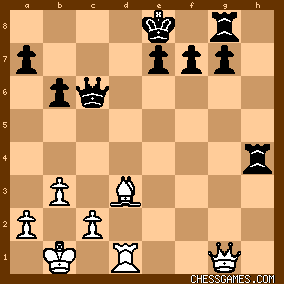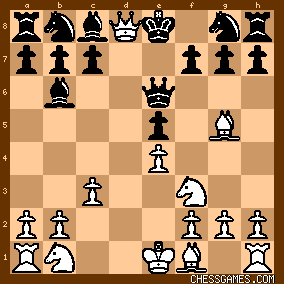|
< Earlier Kibitzing · PAGE 4 OF 4 ·
Later Kibitzing> |
| Apr-16-07 | | YouRang: The rook and bishop mate comes in many flavors. |
|
| Apr-16-07 | | kevin86: This is still yet another version of the Reti-Tartakower game with yet another twist: Instead of using the bishop move to double check,it is used to chase the queen away-and then the black queen is sacfificed. |
|
| Apr-16-07 | | kevin86: <Crowaholic> in case your puzzle is not a rhetorical one,the answer is g5# |
|
| Apr-16-07 | | artemis: boson: thanks for putting that spin on it. (pun most definitely intended!). |
|
| Apr-16-07 | | Cuellargacharna: Good morning!
When a test is given we usually get two kind of comments: Or it was easy, or it was hard; for the ones that knew all the answers was easy, and for the ones that did not was very hard, so I can see the difference of opinions.
For the ones that solve some of these puzzles is less than a second I tip my hat to them; my question to them is how they measure that time 'less than one second', it takes me one second to look at my watch and then at the computer screen and when I am back looking at my watch two seconds has elapsed, so the question is: What type of instrument you use to measure those split second so accurately?
Thanks |
|
| Apr-16-07 | | zb2cr: Quick and simple to see, if you're familiar at all with the Rook + Bishop mating pattern. I think posting your time (being honest, too) is a useful addition. If you're solving these puzzles under simulated games conditions (no moving of pieces, etc.), then being able to solve the puzzle in under circa 5 minutes is an important skill. |
|
| Apr-16-07 | | HannibalSchlecter: Those guys claiming to solve the puzzle in less than a second are the same ones claiming they're going out with a hot babe. Riiiiight! After how many beers fellas? |
|
| Apr-16-07 | | truefriends: <HannibalSchlecter> with this simple 2 mover in which every move is forced you can see it at first glance. I do agree with you on let's say thursday and friday, which are so difficult you have to calculate for a while to check your first thoughts... |
|
| Apr-16-07 | | Crowaholic: I looked at one of the other kibitzer's puzzles - no spoiler intended - and realized that Monday really _is_ queen sac day. So here's a puzzle I created about two months ago (White to play), can Black avoid checkmate for now and at what price?
click for larger view |
|
Apr-16-07
 | | playground player: Ignoring the penchant for Queen sacs featured in Monday puzzles, this should've been an easy one for any regular at CG.com. We should be able to recognize this Rook&Bishop checkmate pattern by now. Right? See it on the board, and wham! Of course, the tricky part is getting there. |
|
| Apr-16-07 | | JustAFish: I actually don't own Polgar's or De La Mazza's book. The former is too big to read at lunch, the latter can be fairly summarized on the back of a post card. For tactics study, I use CT-ART 3.0, mostly. For the trivial stuff, I fall back on Anatoly Lein's tactics book, of which the first 200 or so puzzles are extremely easy. GM endorsement or not, there is some scientific basis to the idea of "chunking" as the means by which one aquires great skill in a realm like chess. The idea is that repetition reinforces the pathways in the brain that deal with that activity. The more repetition, the more reinforcment and with greater reinforcment, comes speedier and more "intuitive" recall Moreover it allows a range of of related concepts to be brought together under one 'unit" which is easier to manage than its individual consituents. For instance, one can chunk the idea of "pawn on f2, g3, h2 and bishop on g2" into the single unit "fianchettoed bishop". This saves time and thought. One can then chunk the idea of "fianchettoed bishop" and pawns on c4, d4 etc,. under a broader topic like "Catalan Formation". Each of these "chunks" has its own characteristics, and aids in figuring out the nuances of larger chunks. Better players have more and more kinds of "chunks." Certainly chunking must help. If one, for instance, has (as Silman says) the "Lucanna" postion in 'muscle memory' (that is, so entirely memorized and reinforced that one can win it almost unconsciously) then one needn't waste effort dealing with its nuances when calculating positions earlier in the game. If one simply knows, intuitively, that a position is (or will be) Lucenna, and one perform it easily, then no calculation of that part of a long chaing of moves is necessary. Given infinite time, this would not be an issue. OTB chess, however has limited time. Similarly, with middlegame tactics, if one simply, because of chunking, has a feeling that a given position is laden with tactical possibilities, then one skips the process (and time) of having to figure this out. Over time, as my chess has improved from "pathetic" to "middling" I've found myself, more and more, encountering positions that simply 'feel' ready for a combination or a certain type of positional move. This sense, brought about by countless tactical exercizes I suspect, is extremely useful. It doesn't absolve me of the need to calculate, from time to time, but I certainly nudges me in the right direction much of the time. |
|
| Apr-16-07 | | JustAFish: <Those guys claiming to solve the puzzle in less than a second are the same ones claiming they're going out with a hot babe. Riiiiight! After how many beers fellas?> I can believe that a puzzle like this could be solved in 1 sec. (It took me about 5 seconds.) Isn't a simul nothing more than a long string of 1 or two second spot calculations which, amazingly, happen upon a decent move in the vast majority of cases? This isn't calculation, it's "feel" or, as I said above, "Chunking." With respect to the other comparison, it should be noted that most of the hot babes out there are involved with <someone>. In other words, <some> lucky guys <or girls to be fair> have hit the jackpot- ergo, it's possible to date a hot babe. |
|
| Apr-16-07 | | javasnob2: Why do suppose Krejcik did 2.exd6? 2.Nf3 seems to defend the e-pawn and force either an exchange of Queens or greatly hamper K-side development. |
|
Apr-16-07
 | | fm avari viraf: It is not the question of solving the puzzle in 1 sec. or 5 mts., it is the question of to relish the beauty of Chess in its different shades. |
|
| Apr-16-07 | | MostlyAverageJoe: <fm avari viraf: it is the question of to relish the beauty of Chess in its different shades> Where is the beauty in this game?
BTW, putting aside my on-going experiment in puzzle difficulty evaluation that causes me to comment on whether the puzzles are easy or not, I agree with: <mkrk17 :...we should concentrate more on what made the game a give-away>. However, in today's POD, white played so badly that it is kinda difficult to turn this puzzle into something educational. |
|
| Apr-16-07 | | MasterSavely: For a moment i was like, whoa, can't find it then i look up, Black to Play.... ohhh.... |
|
| Apr-16-07 | | simsan: I am not going to say that a monday puzzle is too easy, because it's supposed to be easy. But IMHO it would be nice if CG allowed us to explore some other simple tactical themes. Not just the queen sac & #. There should e.g. be plenty of simple forking and pinning tactics to choose from. |
|
| Apr-16-07 | | Timex: What a very easy puzzle. Something similar to Reti-Tartakower, caro-kann. That game assisted me. |
|
| Apr-16-07 | | unferth: badly as he played here, white has database record of +21 -9 =5, including a couple of wins over Reti and some other strong players. he must have been a child when this took place |
|
| Apr-17-07 | | zb2cr: <unferth>,
Yes, he was. If you click on his name, you get to his game profile--and you find he was born in 1885, making him all of 13 years old when this turkey of a game was played. What makes this even more depressing was that this was CORRESPONDENCE. |
|
| Mar-10-13 | | Nightsurfer: The final position in this game here <Josef Emil Krejcik vs Julius Thirring (1898)> - namely, after after <10. ... Qd1+!> ... please see the diagram as follows
...

click for larger view ... , the knock-out <11. ... Rxd1 #> (after <11.Bxd1 ...>) ... please see the diagram as follows ... 
click for larger view... - is based on the matrix of that very checkmate, namely (with colours reversed) the final position in C Lolli vs NN, 1750 after <8.Qd8 #> - please see the diagram as follows ... 
click for larger view... so poor <Josef Emil Krejcik> has not been the only one to having got kicked in the ass like that! |
|
| May-04-14 | | Christoforus Polacco: One of kibitzer wrote :
''I don't like 7.c3, 7.Nc3 developing the knight and now if 7..Bxc3+ 8.Qxc3 White is better than 2 moves before, he has the 2 bishops and will be able to develop his kingside knight on f3''
...
Not quite.
8.Q:c3 N:e4 9.B:d8 N:c3 10.B:c7 Re8+ and game is a some problematic with many possibilities ... to do any mistakes :)For example pressure for ''e2'', ''d3'' and ''c2'' . Try yourselves and have a good fun :)
But I think that it should be an equal position if white not defence ''c2'' pawn. |
|
| Mar-05-18 | | schnarre: ...Nice little miniature. |
|
| Dec-24-21 | | Messiah: Oh dear... what a correspondence miniature! |
|
| Jul-29-23 | | generror: After he began studying Morphy's game, especially the opera game, Krejcik would actually become pretty strong, beating greats like Vidmar, Albin, Lasker, Spielmann, and Réti. |
|
 |
 |
|
< Earlier Kibitzing · PAGE 4 OF 4 ·
Later Kibitzing> |





